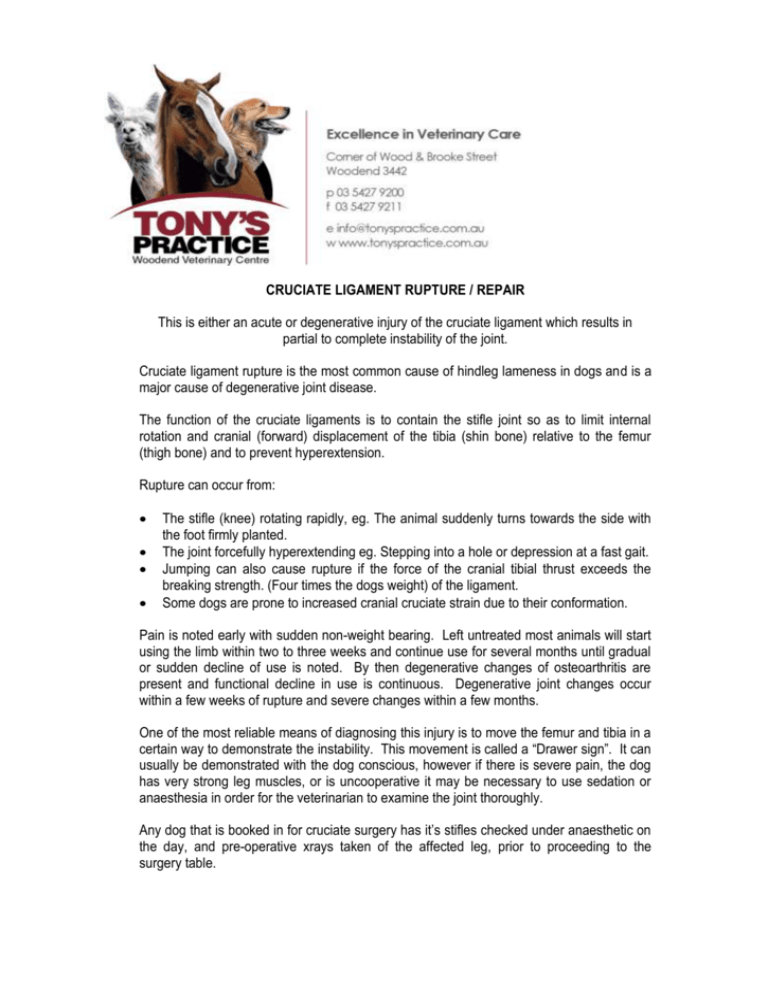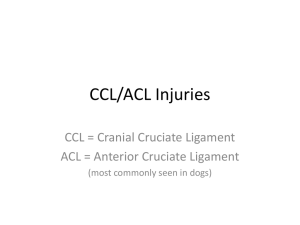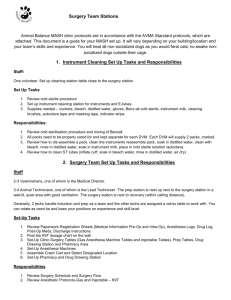CRUCIATE LIGAMENT RUPTURE / REPAIR This is either an acute
advertisement

CRUCIATE LIGAMENT RUPTURE / REPAIR This is either an acute or degenerative injury of the cruciate ligament which results in partial to complete instability of the joint. Cruciate ligament rupture is the most common cause of hindleg lameness in dogs and is a major cause of degenerative joint disease. The function of the cruciate ligaments is to contain the stifle joint so as to limit internal rotation and cranial (forward) displacement of the tibia (shin bone) relative to the femur (thigh bone) and to prevent hyperextension. Rupture can occur from: The stifle (knee) rotating rapidly, eg. The animal suddenly turns towards the side with the foot firmly planted. The joint forcefully hyperextending eg. Stepping into a hole or depression at a fast gait. Jumping can also cause rupture if the force of the cranial tibial thrust exceeds the breaking strength. (Four times the dogs weight) of the ligament. Some dogs are prone to increased cranial cruciate strain due to their conformation. Pain is noted early with sudden non-weight bearing. Left untreated most animals will start using the limb within two to three weeks and continue use for several months until gradual or sudden decline of use is noted. By then degenerative changes of osteoarthritis are present and functional decline in use is continuous. Degenerative joint changes occur within a few weeks of rupture and severe changes within a few months. One of the most reliable means of diagnosing this injury is to move the femur and tibia in a certain way to demonstrate the instability. This movement is called a “Drawer sign”. It can usually be demonstrated with the dog conscious, however if there is severe pain, the dog has very strong leg muscles, or is uncooperative it may be necessary to use sedation or anaesthesia in order for the veterinarian to examine the joint thoroughly. Any dog that is booked in for cruciate surgery has it’s stifles checked under anaesthetic on the day, and pre-operative xrays taken of the affected leg, prior to proceeding to the surgery table. Surgery is recommended in all dogs with this condition as by stabilising the joint, it speeds the rate of recovery, slows degenerative changes and enhances function. 85 – 90% of dogs improve after surgery. While some dogs may not make a complete recovery, surgical repair and rehabilitation significantly increase their quality of life. Some complications can occur: secondary surgery can be required in 10 – 15% of cases due to subsequent damage such as meniscal tears. Regardless of the method of treatment, degenerative joint disease is common, return to complete athletic function is uncommon and there is a possibility of the dog rupturing the cruciate ligament on the opposite leg. Other potential complications include seroma (fluid accumulation under the skin after surgery), infection (as the surgery involves implanting a prosthesis), the dog licking/traumatizing the surgical wound (it is extremely important that a joint surgery of this nature is protected). Some complications are understandably related to the dog being inadequately confined or the dog licking or chewing the surgical wound, so owners need to be prepared to seek help quickly if they are not coping (eg Elizabethan collar, nasty tasting liquid to apply to the wound, sedatives, extra pain relief). A special note must be made concerning weight. Obesity or excessive weight can be a strong contributing factor in cruciate rupture in dogs. The ligament may become weakened due to carrying too much weight; this causes it to tear easily. Obesity will make recovery time much longer, and will make the other knee very susceptible to cruciate rupture. Prior to surgery the activity of dogs with torn cruciate ligaments should be limited to avoid damage to the meniscal cartilage. Where possible physiotherapy can be applied. Method of repair offered at Tony's Practice: D’Angelis Cruciate Repair: this is a common procedure for all dogs. In the D’Angelis method an extra-capsular reconstruction is done using a non-absorbable suture / sutures. The suture passes through deep fascia surrounding the fabella (a small bone at the back of the knee) through a pre-drilled hole in the tibial crest. Tying the suture eliminates the cranial draw as the suture material creates a prosthetic ligament on the outside of the joint. Other methods for repairing damaged Cranial Cruciate ligaments include: Tibial Plateau Levelling Osteotomy (TPLO) Tibial Plateau Levelling Ostectomy (TPO) Triple Tibial Osteotomy (TTO) Tibial Tuberosity Advancement (TTA) These are generally performed by a specialist surgeon. Referral to a suitable facility can be arranged if necessary. What you can do for your dog following cruciate surgery. Passive range of motion (PROM) Passive range of motion is a means of regaining joint mobility and re-training muscles. It is similar to manipulation in that it is moving a joint through and beyond its normal ranges of motion. This technique involves moving the limbs, joints and muscles through their fullest range of extension and contraction possible until the extremity is fatigued. In order to perform PROM the dog’s muscles need to be relaxed and movement must be performed slowly. Using PROM in your pets after care can result in less muscle loss post surgery. Moving through the normal range of motion prevents contractions from forming, and it has been demonstrated that regeneration of cartilage can occur. Passive Range Of Motion ideally should be initiated on the day of the surgery and continued for 2 to 3 weeks. During surgery your dog will be given an injection of a strong pain killer, an antibiotic and an anti-inflammatory. He / she will be also given some tablets to go home with and the leg will be bandaged to reduce swelling around the surgery site. The discharge notes will direct you when to revisit for bandage removal as this can vary depending on the surgeons wishes for the individual case. The sutures will require removal in 10 to 14 days. When you pick your pet up from our hospital he/she will be drowsy. This is quite normal following an anaesthetic and surgery. The drowsiness should reduce over the next 24 hours. Please keep your pet in a quiet place, make sure they are kept warm, and give only a small amount to eat tonight. He/she can have water when you get home. He/she will require a supportive bed to recover on, one that is flat at ground level to enable them to get onto the bed easily and of high density foam (at least 10cm thickness) to avoid bed sores is ideal. The procedure for stifle after care should be used as a guideline dependant on the dogs recovery rate. Your pet will required regular veterinary visits up until they are using their leg sufficiently so the veterinarian can discuss your dogs recovery rate and after care during these regular visits. The evening you take your pet home ice can be applied to your dogs leg for ten minutes at a time if they allow. This will help ease the pain and reduce swelling (eg 10 mins on/30 mins off). Your pet will require support when getting up and down and must stay on a leash when taken outside to go to the toilet. Week 1 Short, controlled leash walks on level surfaces to go to the toilet only. Passive range of motion 20 – 30 repetitions 2 – 3 times per day followed by ice for 20 minutes. At all other times your dog should be confined to a small pen. Week 2 Apply heat for 15 minutes prior to exercise twice a day. Slow leash walks for 5-10 minutes, continue PROM and apply ice after exercise. In between walks your dog may walk around quietly in a small yard or room. Week 3 Increase leash walks to 15 – 20 minutes and include grass walks (slightly uneven surfaces). Week 4 – 6 Continue PROM; increase leash walks to 30 – 40 minutes with gradual incline and decline in terrain. Ice if required. Week 7 – 11 Continue to increase leash walks, adding walk – trot – walk transitions. Continue to increase incline / decline if being tolerated, eg include stair climbs. Swimming. Week 11 onwards Allow to return to normal back yard behaviour. No ball throwing, the dog can do small retrievals but no repetitions. At no time until week 11 post surgery should your dog be allowed to play with other animals or jump onto and off of furniture. Additional information: Physiotherapy can be started following bandage removal. Physiotherapy is commonly used in conjunction with the veterinarian for after care with cruciate ligament rupture, having excellent results. Physiotherapy is a controlled practice used to speed your pets recovery. The use of joint formula made here at Tony's Practice, and a course of Pentosan injections (an anti arthritis injection) during the weeks after surgery and ongoing can be very helpful and is recommended. It may help limit cartilage damage and degeneration. There is usually no additional fee for bandage or suture removal or checking the wound after surgery up to the time of suture removal. However, there are other fees for further medications or if other matters need attending to. Also, there will be further costs if your dog does further injury to the limb and subsequent surgery is required. We hope you have found this information useful. For any other enquires please contact the clinic: we are available 24 hours a day on 03 5427 9200.






